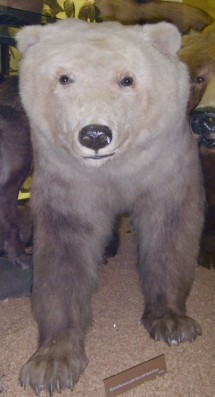This article needs additional citations for verification .(June 2016) |

An ursid hybrid is an animal with parents from two different species or subspecies of the bear family ( Ursidae ). Species and subspecies of bear known to have produced offspring with another bear species or subspecies include American black bears, grizzly bears, and polar bears, all of which are members of the genus Ursus. Bears not included in Ursus, such as the giant panda, are expected to be unable to produce hybrids with other bears. The giant panda bear belongs to the genus Ailuropoda.
Contents
- Brown × black bear hybrids
- Intercontinental brown bear hybrids
- Brown × polar bear hybrids
- Kodiak × polar bear hybrids
- Grizzly × polar bear hybrids
- Asian black bear known or suspected hybrids
- Sloth bear hybrids
- References
- Further reading
A recent study found genetic evidence of multiple instances and species combinations where genetic material has passed the species boundary in bears (a process called introgression by geneticists). [1] Specifically, species with evidence of past intermingling were (1) brown bear and American black bear, (2) brown bear and polar bear, [2] (3) American black bear and Asian black bear. Overall, this study shows that evolution in the bear family ( Ursidae ) has not been strictly bifurcating, but instead showed complex evolutionary relationships.
All the Ursinae species (i.e., all bears except the giant panda and the spectacled bear) appear able to crossbreed.[ citation needed ]

